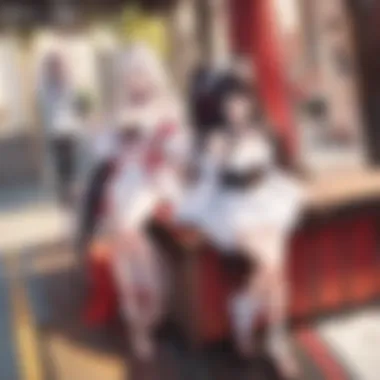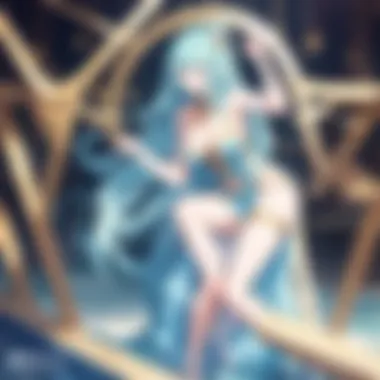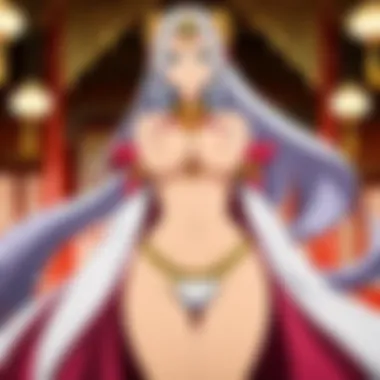Exploring Funimation's Role in Harem Anime Evolution


Intro
The harem genre within anime has garnered significant popularity over the years, often intertwining themes of romance, comedy, and varying character dynamics. Funimation has played a crucial role in shaping this genre, serving as a distributor and promoter of many essential titles. By analyzing its contributions, we can better understand how these narratives appeal to a broad audience.
Key characteristics define harem stories, such as the presence of a central protagonist surrounded by multiple love interests. This setup often leads to comedic misunderstandings, emotional arcs, and sometimes even dramatic moments. As the genre has evolved, Funimation has been at the forefront of bringing both classic and modern harem series to the West, influencing how viewers engage with these narratives.
This article will explore several aspects of Funimation's impact on the harem genre, including episode reviews, character spotlights, and comparisons between anime and manga. We will also discuss industry trends and the viewer reception of critical titles, providing a comprehensive overview for both casual viewers and dedicated fans.
Understanding Harem Anime
Understanding harem anime is crucial to gaining insights into Funimation's impact on the genre. Harem narratives consist of unique storytelling elements that set them apart, influencing both viewers' expectations and the growth of the genre. By exploring the definitions, origins, and key characteristics, we comprehend how Funimation has engaged with, shaped, and distributed these narratives.
Definition and Origins
Harem anime refers to a subgenre characterized by a central male character surrounded by multiple female characters who are attracted to him. This genre emerged in the late 20th century, evolving from earlier manga and anime tropes. The term harem originates from the Arabic word that refers to the separate part of a Muslim household reserved for the women.
Historically, the genre has roots in Japanese romantic comedies but has developed unique features over time. While there are significant variations among series, the core concept remains constant. By tracing the origins, we see a fusion of comedy and romance that caters to a wide range of audience tastes, enhancing its lasting appeal.
Key Characteristics
Understanding the key characteristics of harem anime provides essential context for analyzing its popularity and the role of Funimation in promoting it. The following traits are pivotal:
Protagonist Dynamics
In harem narratives, protagonist dynamics play a fundamental role. The male lead often embodies a relatable, sometimes socially inept, character that viewers can connect with. This representation serves as an entry point for many viewers, especially those seeking escapism or romantic fantasies. The key characteristic of these dynamics is the multi-faceted relationships that develop between the male lead and various female characters.
The appeal of this dynamic lies in its ability to create tension and conflict, which keeps audiences engaged. It offers a blend of humor, drama, and emotional depth, enhancing the overall viewing experience. One unique feature of protagonist dynamics is the evolution of relationships throughout the series, illustrating growth and character development. However, this also predisposes the plot to formulaic outcomes, which may frustrate some viewers.
Character Archetypes
Character archetypes are vital in harem anime, as they define the interactions and relationships among characters. The genre often utilizes well-established archetypes, such as the tsundere, the shy girl, and the childhood friend, which possess distinct traits that allow for immediate recognition and connection. These archetypes help build a familiar narrative structure that fans enjoy.
The key characteristic is the interaction of varied personalities with the protagonist. This array of personalities can lead to both comedic and heartfelt moments that resonate with viewers. The unique feature of character archetypes is their predictability, which can be both an advantage and a disadvantage. While they provide comfort in familiarity, they may also limit character depth and reduce narrative creativity.
Storyline Structure
Storyline structure is another essential aspect of harem anime. Typically, harem series present episodic formats with overarching plotlines focusing on romantic tension among characters. This structure allows viewers to experience meaningful moments while appreciating comedic and emotional beats.
The key characteristic of this structure is the culmination of romantic tension that often leads to climactic moments. This transition from mundane events to significant plot developments creates a satisfying viewing journey. The unique feature of storyline structure in harem anime is its reliance on repetitive scenarios involving misunderstandings or accidental encounters. While this can effectively build anticipation, it may also result in formulaic storytelling, risking monotony.
By delving into these aspects, we develop a richer understanding of harem anime, establishing a foundation for exploring Funimation's contributions within the genre.
Funimation's Role in Harem Anime


Funimation has played a crucial role in the harem anime genre, significantly impacting how these narratives are produced, distributed, and received by audiences. The company's involvement goes beyond mere distribution; it encompasses localization efforts, dubbing, and an insightful curation of content. These elements collectively shape the viewer's experience and understanding of harem anime. By adopting such proactive roles, Funimation has fostered a more robust engagement with the genre that resonates deeply with its audience.
Distribution of Harem Titles
Funimation has established itself as a key player in the distribution of harem anime series. This role is vital because it allows for wider exposure to titles that might only attract niche audiences otherwise. Popular titles such as "To Love-Ru" and "High School DxD" have benefitted immensely from Funimation's robust distribution channels. The reach of their streaming platforms has meant that fans across different regions can access these series more easily.
In addition to traditional distribution methods, Funimation’s strategic partnerships with streaming platforms such as Crunchyroll have provided significant advantages. This symbiotic relationship has allowed for simultaneous releases of new episodes, which is essential for maintaining viewer excitement and engagement.
Localization and Dubbing Impact
Localization by Funimation is another critical aspect of its role in harem anime. The company effectively adapts culturally specific elements to appeal to a wider audience. This process involves not only translating the dialogue but also modifying cultural references to resonate with fans outside of Japan. Proper localization aids in preventing any confusion for viewers unfamiliar with certain Japanese cultural nuances.
Dubbing is a further extension of this impact. Funimation's voice acting is celebrated for its quality. The casting choices and voice direction help bring the characters to life in a way that feels authentic to audiences. Series such as "My Teen Romantic Comedy SNAFU" exemplify how skilled dubbing can enhance character relatability. Good voice acting makes the viewers feel more connected to the characters and, by extension, the series itself.
Curation of Content
Funimation’s curation of content includes careful selection and management of harem titles that it acquires. The company's focus is on series that not only have popular appeal but also merit critical acclaim. This curation ensures that viewers are presented with high-quality content that showcases the depth and variety of the harem genre.
The inclusion of lesser-known titles alongside blockbusters fosters a richer engagement. This approach can introduce fans to unique narratives that diverge from the typical harem formula while still retaining core elements of the genre. Series like "KonoSuba: God's Blessing on This Wonderful World!" offer unconventional twists that contribute to the ongoing evolution of harem storytelling.
Notable Harem Series on Funimation
Understanding the notable harem series available on Funimation is key to appreciating their role in shaping the genre. These series exemplify the core elements of harem storytelling while also pushing boundaries in terms of character development, narrative structure, and thematic exploration. Funimation's platform serves as a digital archive for these works, allowing both new and seasoned viewers access to significant contributions to the harem genre. The series discussed below not only entertain but also invoke discussions around relationships and societal perspectives.
To Love-Ru
Overview and Reception
To Love-Ru stands out in the harem anime scene due to its blend of comedy and science fiction elements. The series revolves around Rito Yuuki, a high school student who finds himself entangled with various alien girls. Its reception has been largely positive, credited for its engaging characters and humorous twists. The unique premise, where romance unfolds amidst intergalactic misunderstandings, appeals to a wide audience. Critics praise To Love-Ru for how it captures young love's chaotic essence. It holds a special place in viewers' hearts as a quintessential harem title, reflecting the genre's essence effectively.
Character Analysis
The character dynamics in To Love-Ru are fundamental to its appeal. Each female lead embodies different archetypes, enhancing the overall narrative depth. Rito's interactions with the various characters provide comedy as well as moments of genuine emotion. Each girl demonstrates her traits, leading to diverse relationship possibilities. This character richness invites viewers to connect with their journeys. The harem structure allows for a variety of relationship outcomes, encouraging audience investment in their developments.
High School DxD
Cultural Impact
High School DxD has generated notable discourse surrounding its representational narrative. The series follows Issei Hyoudou, who finds himself in the middle of a battle between angels and devils. It's renowned for its bold portrayal of fantasy elements which often intersect with harem ideas. Critics often note its unapologetic approach to sexuality and power dynamics. This distinct style has contributed to its popularity, making it a staple in discussions about modern harem anime, especially among more mature audiences.
Themes Explored
The themes within High School DxD are complex, touching on loyalty, betrayal, and power. These themes deepen the narrative, setting the series apart from typical harem fare. The portrayal of supernatural beings alongside romantic interests adds a layer of intrigue. The exploration of these themes provides critical commentary on relationships and consent, pushing viewers to engage more thoughtfully with the content. Its thought-provoking approach is certainly beneficial for discussions on harem dynamics in contemporary settings.


My Teen Romantic Comedy SNAFU
Character Development
My Teen Romantic Comedy SNAFU focuses on character growth, providing a unique angle within the harem genre. The protagonist, Hikigaya Hachiman, navigates high school life with a cynical worldview. This series delves deeper into the psychology of teenage relationships, contrasting traditional harem tropes. The character trajectories unfold in a realistic manner, inviting viewers to relate to their struggles. Hachiman’s development is particularly compelling, as it reflects the complexities of social interaction, making it a crucial consideration for understanding modern harem narratives.
Realism vs. Idealism
The tension between realism and idealism in My Teen Romantic Comedy SNAFU serves as a significant element. The show often deconstructs typical romantic tropes, presenting flawed characters grappling with personal issues. This distinction is important, as it challenges viewers' expectations of harem anime. The balance is struck through clever dialogue and situation-driven narratives, reflecting genuine adolescent experiences. This approach not only resonates with a broader audience but also distinguishes the series from its peers, affirming its status in discussions of the genre.
Viewer Reception of Harem Anime
Understanding the viewer reception of harem anime is essential to grasp its significance and cultural relevance in the genre. The way audiences react to these narratives can inform us about societal norms, preferences in storytelling, and the emotional responses elicited from characters and scenarios within the harem framework. Analyzing viewer reception provides insights into who engages with these series and the possible motivations and expectations behind their popularity.
Demographics of Harem Viewers
The demographic landscape of harem anime viewers is diverse. Primarily, younger audiences, particularly teenagers and young adults, are the largest group engaging with this genre. It appeals to both males and females, although there tends to be a higher percentage of male viewers. This can be attributed to the frequent male protagonist and the array of female characters surrounding him.
Research indicates that harem anime resonates most with viewers aged 15-30 years. This demographic is often searching for escapism, entertainment, and sometimes, idealized relationships. Harem tropes may allow these viewers to explore their fantasies, albeit in a fictional setting. Such factors contribute to the genre's sustained popularity.
Critiques and Praise
Common Critiques
Common critiques of harem anime often center around its predictable plots and character archetypes. Viewers sometimes express frustration when series rely heavily on stereotypical behavior from characters, limiting their development. Critics argue that many harem shows fail to innovate beyond the established formulas, leading to stagnation in storytelling.
However, these critiques also showcase the expectation for storytelling depth and character development. The repetitive use of harem clichés like the oblivious protagonist increasingly frustrates some viewers, but it still resonates with others who find entertainment within the familiar dynamics.
This duality of criticism indicates a significant aspect of viewer engagement with the genre. Understanding these critiques can provide valuable feedback for creators, urging them to break new ground while appealing to traditional fans.
Fan Perspectives
Fan perspectives on harem anime reveal a more nuanced appreciation of the genre. Many fans enjoy the light-hearted and often playful nature of these series. They value the character interactions and often form emotional connections with the characters over time, despite the series' sometimes formulaic narratives.
Another interesting note is how fan communities actively participate in discussions surrounding their favorite titles, often engaging in debates over character choices, storyline arcs, and potential outcomes. Fans often embrace the conventions of the genre, celebrating the charm of unrealistic situations. Their enthusiasm indicates a level of investment that transcends mere viewing, integrating influences from social media and fan forums.
Cultural Themes in Harem Anime
Cultural themes play a significant role in harem anime. These themes provide depth to the narratives and characters, reflecting deeper societal values and issues. As harem anime often explores relationships, gender dynamics, and societal norms, understanding these cultural themes allows viewers to engage with the content on a more profound level. Analyzing how these themes are presented can reveal insights about contemporary views on relationships and identity in different cultures.
Gender Dynamics
Gender dynamics in harem anime often highlight the relationships between the male protagonist and the various female characters. Typically, the male character is portrayed as a somewhat passive individual, while the female characters represent a wide array of personalities and archetypes. This setup allows for exploration of power dynamics and social interactions within romantic relationships.


In many cases, the male protagonist is surrounded by strong female characters who possess distinct traits, skills, and aspirations. For instance, characters can range from shy and awkward to assertive and independent, demonstrating the complexity of female identities. This variety allows for discussions on how traditional gender roles are subverted or reinforced within the medium.
Relationship Norms
Harem anime serves as a lens through which relationship norms can be examined. The interactions between the protagonist and the female characters often reflect contemporary societal views on romance, friendship, and emotional connections. The typical harem scenario depicts the protagonist navigating multiple romantic interests, sometimes leading to complicated love triangles and emotional tension.
These relationship dynamics can present an idealized view of romance. However, they may also initiate conversations about commitment, jealousy, and the importance of communication in relationships. This brings a layer of realism to the often fantastical settings and plots found in harem anime.
Societal Reflections
More broadly, harem anime often reflects societal changes and cultural shifts. It can reveal underlying trends in youth culture, such as the evolving attitudes towards love and dating in contemporary society. The portrayal of characters and their experiences may align with or challenge prevailing social norms.
As these narratives unfold, they often touch on themes such as individualism, autonomy, and the search for identity amidst societal expectations. This engagement with societal issues makes harem anime a relevant genre for academic study and analysis as it mirrors the concerns and aspirations of its viewers.
Harem anime not only entertains but also engages with critical social themes that resonate with its audience. These themes provide viewers a way to reflect on their own experiences and beliefs concerning relationships, gender, and society.
Future of Harem Anime
The realm of harem anime continues to transform as the genre evolves to meet the changing tastes of its audience. It is essential to consider the future of harem anime within the context of cultural shifts, technological advancements, and viewer expectations. This section explores emerging trends and the potential for evolution within this genre that has captivated so many.
Emerging Trends
As harem anime progresses, several trends are surfacing that reflect broader changes in society and media consumption:
- Diverse Relationships: Traditional harem setups often revolve around male leads and female love interests. Currently, there is a notable rise in stories featuring female protagonists or LGBTQ+ dynamics. Series that explore these relationships are more representative of varied experiences, enriching the narrative depth.
- Integration of Technology: With the rise of virtual reality and augmented reality, anime creators may incorporate these technologies into their storytelling. This could permit viewers to engage with characters in interactive environments, blurring the lines between viewer and participant.
- Narrative Complexity: There is a shift from formulaic plots to more intricate storylines. Themes such as trauma, identity, and personal growth are appearing more frequently. Viewers are seeking authentic development arcs that resonate on a deeper emotional level.
"The expectations of anime audiences are shifting. They now demand stories that reflect reality while maintaining the entertainment value."
These trends signal a departure from the conventional formulas that have defined harem anime. Creators are becoming increasingly attuned to audience feedback and cultural discourses that affect representation and storytelling.
Potential for Evolution
The evolution of harem anime holds promise for broader acceptance and innovation. Several factors could influence its trajectory:
- Collaborations Across Genres: Harem elements may blend with other genres, such as psychological thrillers or sci-fi, creating fresh narratives that retain the fundamental aspects of harem while exploring new thematic territories. This hybridization can attract a more extensive audience.
- Globalization of Anime: As anime continues to gain popularity worldwide, creators will likely draw inspiration from diverse cultures. This can lead to a rich tapestry of stories that resonate across different demographics and reflect universal themes of love and conflict.
- Audience Participation: The future may see an increase in viewer involvement through platforms that allow audience feedback to influence storylines. Such interactivity allows for a more customized audience experience which could lead to narratives that are more aligned with viewer preferences.
In summary, the future of harem anime is poised for exciting developments. By embracing emerging trends and potential for evolution, the genre can adapt to the shifting cultural landscape while continuing to entertain and resonate with its audience.
The End
Summary of Insights
- Distribution of Harem Titles: Funimation’s extensive catalog includes numerous harem anime, making it accessible for fans and newcomers alike. This variety allows viewers to explore different narratives and character dynamics, enriching their understanding of the genre.
- Localization and Dubbing Impact: The quality of localization and dubbing offered by Funimation ensures that harem anime resonates with wider audiences. This process preserves the essence of original dialogues while adapting cultural nuances, making the content relatable.
- Curation of Content: Funimation strategically curates its harem offerings, choosing series that reflect diverse themes and storytelling styles. This curation helps in defining what harem anime represents in modern contexts.
- Viewer Reception: Viewer demographics and their responses show that harem anime appeals to a broad audience, but the critiques and praises illuminate the complexities of its narratives. The engagement of fans adds to the breadth of discussions around the genre.
- Cultural Themes: Reflection of societal norms and gender dynamics in harem anime invites viewers to think critically about the representations presented. Funimation’s role in popularizing these themes marks a significant progression for the genre.
Final Thoughts
The exploration of Funimation’s impact on harem anime showcases a rich interplay between media distribution and audience engagement. Future developments in the genre are likely to continue evolving, possibly leading to fresh interpretations and innovative storytelling approaches. As anime continues to gain recognition worldwide, Funimation’s influence will remain vital in establishing dialogues around harem narratives and their thematic undertones.
In summary, understanding Funimation's contribution not only enhances appreciation for harem titles but also promotes a thoughtful examination of the cultural narratives at play. Anime fans and scholars alike can benefit from recognizing these aspects to navigate the genre with greater insight and awareness.







